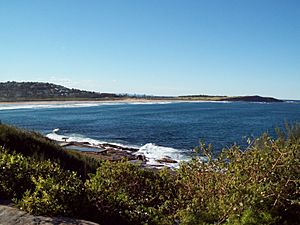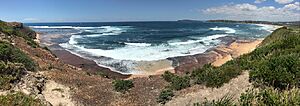Dee Why facts for kids
Quick facts for kids Dee WhySydney, New South Wales |
|||||||||||||||
|---|---|---|---|---|---|---|---|---|---|---|---|---|---|---|---|

Dee Why Beach
|
|||||||||||||||
| Population | 21,518 (2016 census) | ||||||||||||||
| Postcode(s) | 2099 | ||||||||||||||
| Elevation | 20 m (66 ft) | ||||||||||||||
| Location | 18 km (11 mi) north-east of Sydney CBD | ||||||||||||||
| LGA(s) | Northern Beaches Council | ||||||||||||||
| State electorate(s) |
|
||||||||||||||
| Federal Division(s) | |||||||||||||||
|
|||||||||||||||
Dee Why is a lively coastal suburb in northern Sydney, New South Wales, Australia. It's about 18 kilometres north-east of the Sydney city centre. Dee Why is an important hub for the Northern Beaches area. It is also the main office location for the Northern Beaches Council, which manages the local area.
Contents
Discovering Dee Why's Past
How Did Dee Why Get Its Name?
The exact reason for the name Dee Why is still a bit of a mystery! The earliest mention of the name comes from a note by surveyor James Meehan in 1815. He wrote "Dy Beach" in his field book.
Some people think:
- The letters "DY" were just a special mark Meehan used for many places on his maps.
- The name might have come from the local Aboriginal language. Meehan often used Aboriginal names for the places he surveyed.
From 1840, the name was often written as one word, 'Deewhy'. Other nearby areas like Narraweena (once called 'Dee Why Heights') and Cromer (once 'Dee Why West') also had "Dee Why" in their names.
Early People of Dee Why
We don't know much about the Aboriginal people who lived in Dee Why before Europeans arrived. However, there is proof they were here, like a shell midden (a pile of shells from old meals) found at the south end of Dee Why Beach. These early people were known for fishing in the lagoon, where many black swans used to live.
How Dee Why Grew Over Time
The first land in Dee Why was given to William Cossar in the early 1800s. Later, much of the land was bought by James Jenkins and his family. Elizabeth Jenkins, James's daughter, gave all her land to the Salvation Army in 1900. This was because they had helped her when she was older. The Salvation Army received a lot of land, including about 200 acres in Dee Why. They set up a farm and homes for boys, girls, and women there.
In 1906, the Warringah Council was formed, giving local people a say in how Dee Why was run. In 1912, a tram line was extended to Dee Why, making it easier to travel to and from Manly. This made the area more popular. Because of this, the Salvation Army started selling off much of its land in 1913. One of the main streets in Dee Why, Oaks Avenue, is named after one of these land sales. Another street, Howard Avenue, is named after Commissioner Thomas Howard, an important leader of the Salvation Army. By 1920, most of Dee Why had been divided into smaller blocks for homes. The trams stopped running in 1939 because there weren't enough people using them, and new bus routes were available.
In 1971, work began on a new civic centre for Dee Why. This building was finished in 1972, and the Council moved its offices there in 1973. This made Dee Why the main administrative centre for the Warringah area.
Dee Why's Natural Beauty

Dee Why is located in the area drained by Dee Why Lagoon. It stretches from Victor Road in the west to Dee Why Beach in the east. The Bicentennial Coastal Walkway is a path that goes along the cliffs of Dee Why Head. This path shows off the coastal heath ecosystem, which is a type of bushland that used to cover much of the area. This area has been carefully restored since 1991.
Another special natural spot in Dee Why is the Stony Range Botanic Garden. It was created in 1957 on the site of an old quarry. This garden has plants from all over Australia, as well as plants native to the area. It has different sections, including a rainforest gully and a section with very old plant species. The garden is free to enter and is open every day except Christmas Day.
Dee Why Beach

Dee Why Beach is about 1.2 kilometres long and faces the Tasman Sea. At the northern end are sand dunes that separate the beach from Dee Why Lagoon. The southern end has the Ted Jackson Reserve, a nice spot for picnics with old Norfolk Island Pines. There's a seawall along part of the reserve, which was updated in 2006. You can find playgrounds, picnic areas, and ocean pools at the beach. There are also car parks nearby.
Dee Why Lagoon
Behind the beach dunes, you'll find Dee Why Lagoon. This lagoon is very important for local and migrating birds. In 1973, it was made a wildlife refuge to protect its natural value. It's a major scenic spot in the Northern Beaches and covers about 77 hectares, with the lagoon itself being 30 hectares. The rest of the area is mostly swampy bushland and coastal dunes.
Shopping and Services
Dee Why has a busy commercial area mainly along Pittwater Road, which is the main road in the Northern Beaches. This area has many shops, cafes, and restaurants.
There are several shopping centres in Dee Why:
- Dee Why Market – This centre was updated in 2009.
- Dee Why Village Plaza – Here you'll find a Coles supermarket.
- Dee Why Grand – This is a large complex with shops, apartments, offices, and a Coles supermarket. It also has an Aldi store.
- Meriton Retail Precinct Dee Why – This is an outdoor shopping area that is part of the Lighthouse development.
The Northern Beaches Council Chambers and the Dee Why branch of the Warringah Library are also located on Pittwater Road.
The Strand, which runs along Dee Why beach, is another popular area. It has many apartments, cafes, restaurants, and bars with views of the beach.
Getting Around Dee Why
Public transport in Dee Why mainly uses buses along Pittwater Road. You can catch buses south to the city, Manly, and North Sydney, or north to Collaroy and Narrabeen. There are also buses to Chatswood. Dee Why has a B-Line bus stop, which offers frequent services to the city and Mona Vale. Express buses also run during peak hours for commuters.
Sports and Fun
Dee Why has many sports clubs for people of all ages.
- The Dee Why Lions are a well-known rugby union team. They have teams for children and adults.
- The Dee Why Football Club, also called "The Swans," is a soccer club started in 1946. It's one of the oldest soccer teams in the Northern Beaches.
- The Dee Why Surfing Fraternity is Australia's oldest surfboard riders club, started in 1961. They still have competitions every month.
Schools in Dee Why
Dee Why has several schools:
- Dee Why Public School (opened 1922)
- Fisher Road Special School (opened 1953)
- St Kevin's Catholic Primary School (opened 1935)
- St Luke's Grammar School (started 1993) – This is an Anglican school for students from kindergarten to Year 12.
Places of Worship
Dee Why has many churches for different Christian groups. The oldest church building is the former Methodist Church, now part of the Uniting Church.
- St John's Anglican Church (established 1922) is known for its beautiful modern stained glass windows.
- St Kevin's Catholic Church (established 1923) has a unique design that looks like a tent.
- The Dee Why Baptist Church (1940) was renamed the New Life Baptist Church in 2000.
- St David's Uniting Church was built in the 1940s as a Presbyterian church.
- The Salvation Army still has a church in Dee Why. There is also a Jehovah's Witness Kingdom Hall.
People of Dee Why
In the 2016 census, Dee Why had 21,518 residents. About 52% of people were born in Australia. Many people also came from England, China, India, Brazil, and New Zealand. Most people (61.5%) spoke only English at home, but other languages like Portuguese, Mandarin, and Tibetan are also spoken. Dee Why has more apartments than the average for Australia, with nearly 80% of homes being flats or units.
A famous person who lived in Dee Why was Edward (later Sir Edward) Hallstrom. In 1923, he invented a special refrigerator that ran on kerosene in his backyard shed.
How Dee Why is Governed
Dee Why is part of the Northern Beaches Council local government area. The Warringah Civic Centre, built in 1973, is located here. It houses the Council Chambers. Dee Why is divided between two federal electorates: Warringah and Mackellar. It is also in two state electorates: Wakehurst and Manly.
Images for kids
See also
 In Spanish: Dee Why para niños
In Spanish: Dee Why para niños














